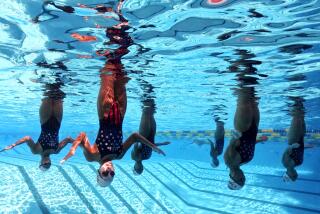Even Yachts Have Back-seat Drivers : The Tacticians Are the Key Men in America’s Cup Racing
- Share via
FREMANTLE, Australia — When Chris Dickson wants to know what’s happening in the great, wide, wonderful world of 12-meter racing, he turns to tactician Brad Butterworth.
“If we’re coming to a crossing (with another boat), and it’s going to be close,” said Dickson, skipper of high-flying America’s Cup entry New Zealand, “I’ll ask Brad if we’re going to clear.
“It usually takes him a few seconds. Then he’ll say, very calmly, ‘We’ll clear.’
“So I keep going. He might say, ‘OK, go for speed now,’ but he’s always calm. His tone never changes.
“Then all of a sudden, whoosh ! There goes the other guy’s bow, two feet from the back of the boat.”
That’s 60,000 pounds of pointy-ended power, 24 inches from splintery disaster. And Butterworth? “He never moves a muscle,” Dickson said.
When John Kolius wants to know how his America II is doing in a race, he consults his tactician, John Bertrand.
If Bertrand gives a quick reply, Kolius knows he’s all right. But if Bertrand goes silent on him, gloom descends on America II. “When J.B.’s quiet, everyone knows we’re in trouble,” Kolius said.
If Tom Blackaller needs advice, he turns to Paul Cayard, who doesn’t always tell the truth.
“There’s an element of keeping the feedback positive,” said Cayard, tactician on Blackaller’s San Francisco entry, USA. “The other guy can be hurting us, but you know it’s going to turn around. It’s then you either say nothing or fudge a little. You don’t want to upset the apple cart.”
Dennis Conner ought to pay psychologist fees to Tom Whidden. “One of my jobs is to keep Dennis under control in a bad situation,” Whidden said. “Sometimes, it’s up to the tactician to have a calming effect on the crew.”
Meet the tacticians, the level thinkers in the back of the boat who call the shots in America’s Cup racing. They have to. The skipper usually can’t see what’s going on.
Twelve-meter yachts operate under such a cloud of Mylar, Kevlar and Dacron sails, and there are so many instruments on board to keep track of, that the only time the helmsman sees his opponent clearly is to exchange greetings after the race.
After the start, where they operate on instinct in close quarters, skippers become high-profile drones, chained to the helm and the instruments, straining for an extra tenth of a knot in speed and largely doing as they are told by their tacticians.
The role of tactician has grown so vital here that some skippers are relinquishing the wheel to do the job themselves.
Blackaller turned the helm over to Cayard last week, trading places for several races. British skipper Harry Cudmore always gives the wheel to Chris Law after the start in White Crusader’s races and spends the rest of each race calling tactics.
So crucial is the tactician’s role that on troubled Canada II, skipper Terry Neilson sacked his best friend, tactician Andy Roy, after the boat fared poorly in the first round of trials and replaced him with Greg Tawaststjerna.
In the fascinating world of 12-meter racing, the tactician is coming into prominence. He’s the eyes and brains of the operation.
There are 10 other positions on a 12-meter, but few leave time for thinking or looking. The bow man, mast man and pit man up forward, the sewer man below, the grinders, tailers and mainsail trimmer amid ships all have their hands full. The skipper has the wheel and the speed gauges to worry about.
The navigator, universally called the naviguesser, has his head buried in electronics much of the time, and the rest of the time is searching the course for wind and feeding that information to the tactician.
Only the tactician gets to regularly filter information directly to the skipper. Using a hand compass to determine bearing and occasionally a statometer to measure distance to his foe, he figures whether he’s ahead or behind, gaining or losing, and what to do about it.
The principles are simple. A two-boat match race is like a one-on-one basketball game. The boat ahead plays defense, trying to keep the other boat from getting around it; the boat behind has the ball and will do anything within the rules to get first to the hoop, which in yachting is the finish line.
Whidden, who called tactics in the historic seventh race of the 1983 series when Conner became the first American to lose the Cup, said if you’re the faster boat, the rule is simple: Get ahead and cover your rival like a blanket, matching his moves and staying between him and the finish.
If you’re slower, it’s more complex. You have to take chances.
The classic example was Conner’s fateful decision three years ago to jibe away from Australia II on the next-to-last leg of the race that changed yachting history.
Conner led, but Whidden said the Aussies had cut the lead in half in the first few minutes of the leg.
So Conner, going slower, took a plunge, went off on a new course looking for fresher air, sailed into a breezeless hole and lost yachting’s greatest prize.
Given the situation, said Whidden, he would do the same thing today. “What were we supposed to do, sit there and let them pass us?”
Now, Whidden and Conner have a new boat with new strengths and deficiencies, a new set of foes, and tactics to refigure every time they take the water. “We formulate tactics in advance, based on what we think the two boats will do, but then you have to reassess everything based on the rates of gain.”


